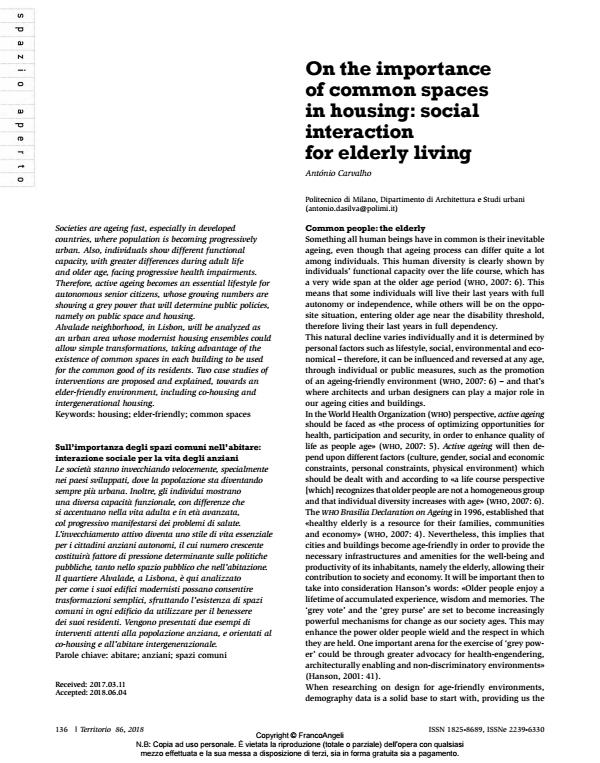On the importance of common spaces in housing: social interaction for elderly living
Titolo Rivista TERRITORIO
Autori/Curatori António Carvalho
Anno di pubblicazione 2019 Fascicolo 2018/86 Lingua Inglese
Numero pagine 10 P. 136-145 Dimensione file 564 KB
DOI 10.3280/TR2018-086018
Il DOI è il codice a barre della proprietà intellettuale: per saperne di più
clicca qui
Qui sotto puoi vedere in anteprima la prima pagina di questo articolo.
Se questo articolo ti interessa, lo puoi acquistare (e scaricare in formato pdf) seguendo le facili indicazioni per acquistare il download credit. Acquista Download Credits per scaricare questo Articolo in formato PDF

FrancoAngeli è membro della Publishers International Linking Association, Inc (PILA)associazione indipendente e non profit per facilitare (attraverso i servizi tecnologici implementati da CrossRef.org) l’accesso degli studiosi ai contenuti digitali nelle pubblicazioni professionali e scientifiche
Societies are ageing fast, especially in developed countries, where population is becoming progressively urban. Also, individuals show different functional capacity, with greater differences during adult life and older age, facing progressive health impairments. Therefore, active ageing becomes an essential lifestyle for autonomous senior citizens, whose growing numbers are showing a grey power that will determine public policies, namely on public space and housing. Alvalade neighborhood, in Lisbon, will be analyzed as an urban area whose modernist housing ensembles could allow simple transformations, taking advantage of the existence of common spaces in each building to be used for the common good of its residents. Two case studies of interventions are proposed and explained, towards an elder-friendly environment, including co-housing and intergenerational housing.
Le società stanno invecchiando velocemente, specialmente nei paesi sviluppati, dove la popolazione sta diventando sempre più urbana. Inoltre, gli individui mostrano una diversa capacità funzionale, con differenze che si accentuano nella vita adulta e in età avanzata, col progressivo manifestarsi dei problemi di salute. L’invecchiamento attivo diventa uno stile di vita essenziale per i cittadini anziani autonomi, il cui numero crescente costituirà fattore di pressione determinante sulle politiche pubbliche, tanto nello spazio pubblico che nell’abitazione. Il quartiere Alvalade, a Lisbona, è qui analizzato per come i suoi edifici modernisti possano consentire trasformazioni semplici, sfruttando l’esistenza di spazi comuni in ogni edificio da utilizzare per il benessere dei suoi residenti. Vengono presentati due esempi di interventi attenti alla popolazione anziana, e orientati al co-housing e all’abitare intergenerazionale.
Keywords:Abitare; anziani; spazi comuni
- Bernard, S.L., Zimmermann, S., Eckert, J.K., 2001, «Aging in Place». In: Zimmerman S., Sloane D., Eckert J.K., (eds.), Assisted Living: needs, practices, and policies in residential care for the elderly. Baltimore: The John Hopkins University Press.
- Carvalho A., 2010, Residências Assistidas – Projecto de Investigação Qualidade dos Equipamentos Sociais, Outras Formas de Habitar. Lisboa: LNEC.
- Carvalho A., Heitor T.V., Reis Cabrita A., 2012, «Ageing cities: shifting from special needs to inclusive design in urban space». In: Pinto da Silva M. (ed.), EURAU 12: Public Space and Contemporary City, European Symposium on Research in Architecture and Urban Design. Porto, 12-15 Setembro 2012. Porto: FAUP.
- Carvalho, A., 2013, Habitação para idosos em Lisboa: de colectiva a assistida. O caso de Alvalade. PhD thesis. Lisboa: Instituto Superior Técnico da Universidade Técnica de Lisboa.
- Dischinger M., Ely V.B., Piardi S.G., 2009, Promovendo acessibilidade espacial nos edifícios públicos: programa de acessibilidade às pessoas com deficiência ou mobilidade reduzida nas edificações de uso público. Florianápolis: s.n. Fundação para o Desenvolvimento Social do Porto, 2012, Regulamento do Programa Aconchego. -- www.bonjoia.org/files/Regulamento_Aconchego.pdf (accessed on: 2012.07.24).
- Gonçalves C., Carrilho M.J., 2007, «Envelhecimento crescente mas espacialmente desigual». Revista de estudos demográficos, 40: 21-37.
- Hanson J., 2001, «From Sheltered Housing to Lifetime Homes: an inclusive approach to housing». In: Winters S. (ed.), Lifetime Housing in Europe. Leuven: Katholieke Universiteit Leuven.
- Hanson J., 2002, «The Inclusive City: what active ageing might mean for urban design». In: Maltby T., Littlechild R., La Fontaine J., Hunter S., Branelly P. (eds.), Active Ageing: myth or reality. Proceedings of the British Society of Gerontology 31st Annual Conference. Birmingham: University of Birmingham.
- Hanson, J., 2004, «The inclusive city: delivering a more accessible urban environment through inclusive design». In: (Proceedings), Responding to Change. rics Cobra 2004 International Construction Conference. York.
- Hillier B., Hanson J., 1984, The Social Logic of Space. Cambridge: Cambridge University Press.
- Huber A., 2008, dir., New Approaches to Housing for the Second Half of Life. Basel: eth-Birkhauser.
- Jacobs J., 1992. The Death and Life of Great American Cities. New York: Vintage Books, or. ed. 1961.
- Pastalan L., 1990, dir., Aging in Place: The Role of Housing and Social Supports. New York: Haworth Press. Perry C., 1929. The Neighborhood Unit. New York: Regional Plan of New York and Its Environs, 1974. -- http://codesproject.asu.edu/node/11 (accessed on 2012.01.10).
- Pynoos J., Hamburger L., June A., 1990, «Supportive relationships in shared housing». Journal of housing for the elderly, 6: 1-24.
- Regnier V., 1994, Assisted Living Housing for the Elderly: design innovations from the United States and Europe. New York: John Wiley and Sons.
- Regnier V., Scott A., 2001, «Creating a Therapeutic Environment: Lessons from Northern European Models». In: Zimmerman S., Sloane D., Eckert J.K. (eds.), Assisted Living: needs, practices, and policies in residential care for the elderly. Baltimore: The John Hopkins University Press. who-World Health Organization, 2007, Global age-friendly cities: a guide. Geneva: who Press.
- un-United Nations, Department of Economic and Social Affairs, Population Division, 2013. World Population Ageing 2013. (st/esa/ser.a/348). New York: United Nations.
- un-United Nations, Department of Economic and Social Affairs, Population Division, 2015. World Population Ageing 2015. (st/esa/ser.a/390). New York: United Nations.
- un-United Nations, Department of Economic and Social Affairs, Population Division, 2017. World Population Prospects: The 2017 Revision, Key Findings and Advance Tables. Working Paper No. esa/p/wp/248. New York: United Nations.
António Carvalho, On the importance of common spaces in housing: social interaction for elderly living in "TERRITORIO" 86/2018, pp 136-145, DOI: 10.3280/TR2018-086018